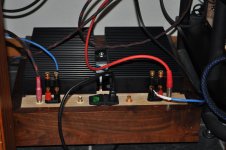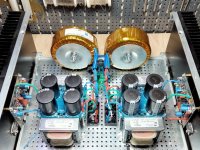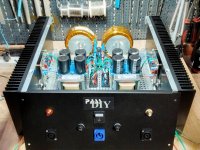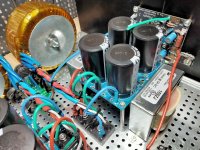Thank you, Dennis. Good learning.I see this in post #3:
"Now to increase the bias to the recommended amount, 400mV (I had it just on the edge and the meter read .39 when I took the photo….) 400mV bias = .85A = 18W/device"
The 18W here refers to the each mosfet's dissipation. 6L6 measured distortion for ~1W into 4 ohms at different levels of bias current.
OTOH, booz might be just the medicine if stated values were correctthe other way?
433mV across 0R47, ~0V at output
yup, booz time 🙂

I should have checked to see if I have values in the right spot and messed it up. Not surprised to say the least.
I should have checked to see if I have values in the right spot and messed it up. Not surprised to say the least.
No matter. It works! Kudos, and congrats! Happy?
Very, very nice indeed! You are a master of perseverance, creativity and beautiful work. God damn ‘talians! 

Wow! Super clean symmetrical work. Well done 👏🏻Congrats!
Very slow progress here, thanks to continue health problems...
View attachment 1014462
View attachment 1014463
View attachment 1014464
Tomorrow PSU test and final wiring
Tomorrow PSU test and final wiring
Well, i really like it! It is very soon time for you to let the magic smoke out

But Andy has a Muscle Amp 💪it's più bello di Andy's

Do I have to put bleeder res?
But Andy has a Muscle Amp 💪
Do I have to put bleeder res?
Yours is delicate and beautiful like a flower

No, you don’t have to use bleeders. I considered not putting them in. But for both practical and safety reasons I did. For example: do you want to have to wait two days before being able to disconnect your speakers without risking shorting the outputs? Consequence of course grossly exaggerated, but my point is use them if you in any easy way can. At least if you plan on tinkering with stuff inside the amp 🙂
Oooooooooh, that is pretty! Drooling a bit. I STILL have to try / convert one of my PSUs to CLC. Projects, projects.
re: bleeders. FWIW, I put them in all of mine. I KNOW that I should have a process for discharging PSU caps before any maintenance, but it's safer for me with my bad memory to have them in. YMMV, and many do not use them.
Edited to add - Seems Andy and I posted around the same time with roughly the same answer. 😀
re: bleeders. FWIW, I put them in all of mine. I KNOW that I should have a process for discharging PSU caps before any maintenance, but it's safer for me with my bad memory to have them in. YMMV, and many do not use them.
Edited to add - Seems Andy and I posted around the same time with roughly the same answer. 😀
damn greenhornsYours is delicate and beautiful like a flower
No, you don’t have to use bleeders. I considered not putting them in. But for both practical and safety reasons I did. For example: do you want to have to wait two days before being able to disconnect your speakers without risking shorting the outputs? Consequence of course grossly exaggerated, but my point is use them if you in any easy way can. At least if you plan on tinkering with stuff inside the amp 🙂

Buddha forbid! that caps are bled through loudspeakers
without loudspeakers, caps are perfectly soaked down with amp itself........ case with majority of A Class amps ......... only wakoo ones having different OS elements and different rail consumption (think Sissy, think Schade) are leaving some juice in neg side caps
but , nothing to worry
but!!!!!!!!!!!!! if you're damn greenhorn, forgetting to bleed your caps after testing PSU alone, prior to connecting channel pcbs - to avoid zap!!!! during wiring - put bleeders on
if you're not forgetting type of damn greenhorn ( as I am, chicken), you really don't need bleeders at all
ZM - I totally agree (per usual). Because I am a stupid greenhorn AND I love to swap out PSUs and amp boards... I leave them. I do A LOT of mix and match with all sorts of pieces with other pieces.... so, I like to have the bleeders. I've only built two amps that have stayed in their original chassis and been connected to the same PSU for over a few months (the BJ2 and my "final" version of the BA-3).
Each time I take an amp apart into its "modules", I'll set bias current and other startup conditions back to "0". I rebias and set it up again properly when I put it into new chassis / hook it to new PSU etc. Same with PSUs.
With each PSU, I check it unloaded when I pull it out of storage before hooking it to any amp boards / FE boards etc. etc. When I convert from CRC to CLC or use regulated supply, or CapMX or some other configuration, I like to test the supply on its own each time. So, I like to have the bleeders in place. It just makes one less thing I need to worry about when testing. If I were to ever build an amp that I knew would never be taken apart again, I'd likely leave out bleeders / power rail LED indicators etc. But... when playing with the Legos ... I like to have them. Hope that makes sense.
Each time I take an amp apart into its "modules", I'll set bias current and other startup conditions back to "0". I rebias and set it up again properly when I put it into new chassis / hook it to new PSU etc. Same with PSUs.
With each PSU, I check it unloaded when I pull it out of storage before hooking it to any amp boards / FE boards etc. etc. When I convert from CRC to CLC or use regulated supply, or CapMX or some other configuration, I like to test the supply on its own each time. So, I like to have the bleeders in place. It just makes one less thing I need to worry about when testing. If I were to ever build an amp that I knew would never be taken apart again, I'd likely leave out bleeders / power rail LED indicators etc. But... when playing with the Legos ... I like to have them. Hope that makes sense.
- Home
- Amplifiers
- Pass Labs
- Aleph J illustrated build guide




